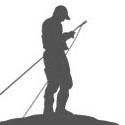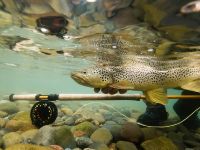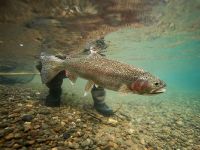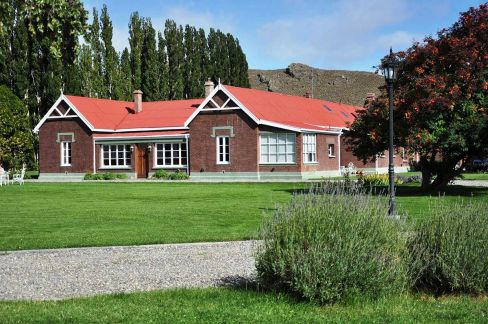CATCH AND RELEASE: HOW IT CAME TO BE
Today, it is hard to imagine a quality fishery where fly fishers do not return their catch to the water alive. This is the standard on the rivers in Patagonia. Releasing their fish is the practice of both fishers and guides. It is taken for granted, as if it had always been this way. It is not even questioned; what is more, many people are not aware that things were the exact opposite not very long ago. In fact, it was a real struggle to establish the culture of ‘catch and release’. It took time, hard work and countless battles.
Many years ago, when I discovered fly fishing as a teenager, I obsessively searched for publications on the subject. Most, if not all, were written in English and came from the United States. As soon as I began to read, it became apparent that the concept of ‘catch and release’, which was frequently mentioned, was of the utmost importance.
The notion of ‘catch and release’ was introduced to Argentina by Joe Brooks, and those who fished with him between the mid ‘50s and late ‘60s carried on his legacy. Jorge Donovan may have been the one who grasped the concept and its implications better and faster, and probably the one who first persuaded me it was imperative to spread it and implement its practice in order to prevent the resource from being definitively degraded. Mel Krieger was also a great influence on my convictions and a keen advocate of ‘catch and release’ which he never failed to mention in his presentations or whenever the opportunity arose.
While some of us had already adopted the practice, it was vital for others to do so as well in order to achieve real results in the fish population, especially in the larger, higher quality fish. In the ‘70s it was common practice to kill and take home the best catch, whereas sometimes the smaller ones were returned. This was, of course, exactly the opposite of what should have been done. The systematic killing of the larger fish would eventually result in a population of small sized fish, including adults. It could be called an inverted genetic selection, where instead of preserving good specimens and allowing them to reproduce, they were being killed. As long as the fishing pressure remained low, the resource could have resisted its degradation to a certain extent, but as angling became more popular, the outcome would have been devastating.
Although it was repeatedly explained in US publications in which anglers were encouraged to practice ‘catch and release’ and spread the concept, it was relatively new in the country, and was not yet widespread. In the places where it was practiced, such as private spring creeks, some rivers in national parks and so on, the quality of the fishing was much higher than where it was not. Besides, American fly fishers like Mel Krieger, whom I mentioned before, publications, specialized magazines and institutions such as Trout Unlimited and Federation of Fly Fishers among others, were truly committed to spreading the culture in their own country .
In the late ‘70s Jorge Donovan gave me a study carried out and published by Trout Unlimited showing the mortality rate of returned live fish at 4%. This meant that statistically, out of 100 returned trout, only 4 died, while 96 survived. Obviously, 4% mortality was much better than 100%, as was the case at the time, since most of the fish caught were killed. Fishing regulations in Patagonia allowed killing 4 trout or salmon per person, per day. Unfortunately, it was easy to kill more, which was what usually happened.
When I settled in San Martin de los Andes and became a professional fishing guide, I was fully aware of the importance of advocating ‘catch and release’ although it involved a drastic cultural change, a paradigm shift. It was the locals, especially, who had to be persuaded that it was the best policy to ensure long term quality fishing in the area which would naturally result in greater economic benefits for the community as a whole, when anglers from all over the world visited us.
On one of his trips, Jorge Donovan kindly gave me a movie called ‘The Way of a Trout´, produced and edited by Trout Unlimited in the US. I repeatedly showed it in San Martin de los Andes and, with the help of a well-known fisherman and staunch supporter of the cause, Chiche Aracena, arranged for it to be aired on the only TV channel in Neuquén at the time, the very evening before the 1983 opening day of the fishing season. The movie was in English so I simultaneously interpretedit in Spanish. It tells the story of a determined fisherman who, after an extremely long struggle, finally succeeds in catching a good sized trout in a remote, hidden pool but decides to return it to the river after reflecting on the trout’s life. Most of the movie shows what the trout has to endure, the enemies it has to avoid and the difficulties it has to face to survive and reach a good size, as only a small percentage do. The moral of the story is that trout which reach a large size are generally the strongest and best adapted, which is why it is essential to preserve them.
In 1981, Jorge Donovan and I drafted a fishing regulation project proposing ‘catch and release’ and ‘fly fishing only’ for a stretch of the Upper Malleo River. The project was welcomed by the Neuquén Department of Wildlife and everything went smoothly. However, the final meeting in Junín de los Andes, was interrupted by the untimely appearance of Ginés Gomariz, an experienced, multiple style fisherman, and a group of boisterous followers. They strenuously opposed the ‘practices’ which, in their opinion, only benefited foreign anglers (like the ones I guided) ‘at the expense of the locals’, and words to that effect. Unfortunately, the government officials became uneasy and decided not to innovate. That was our first failed attempt.
Ginés Gomariz wrote several sport fishing books and magazine articles. I had one of his books, actually a guide, in which he explained fishing techniques, besides fly-fishing, in the different environments in Argentina. We were mates and shared fishing outings on the Malleo and the Chimehuín. We often met at the ‘boca’ of the Chimehuín where he once took a picture of me after I had landed a 4-kilo brown. He had moved to Junín de los Andes in 1979 and set up a fishing store where he sold not only fly-fishing tackle, but spinning and trolling tackle and equipment to a diverse clientele. I suppose that his fear of change arose from the thought that customers would be discouraged from coming to the area to fish, thus affecting his business. He was by no means the only one; Héctor Sainz, another well-known angler from the city of Neuquén who also worked in a fishing store, opposed ‘catch and release’ regulations, too. In addition, fishing clubs in the city of Neuquén such as El Biguá and particularly Huepil Leufú loudly voiced their opposition to returning live fish to the water. Some of them simply couldn’t conceive the idea and completely rejected it.
Unfortunately, many local people agreed with them. I argued that, on the contrary, ‘catch and release’ would not only prevent the trout population from being decimated, but would substantially improve the quality of the fishing area. This would bring about the arrival of a larger number of visitors who would be willing to pay more for the services of a fishing trip. I emphasized that my proposal only involved a stretch of the Upper Malleo River for experimental purposes. I truly believed that if I could make it happen, in a few years that section would offer far superior fishing quality to the rest of the rivers, so the idea would advertise itself and eventually ‘catch and release’ would expand to the other rivers. Perhaps others suspected this and it scared them.
Despite the numerous meetings and heated discussions at the Department of Wildlife to determine the fishing regulations, my conviction never wavered. By 1985 I had gained allies, fellow guides like Gustavo Olsen and Ramón Aranguren, as well as citizens from both Junín and San Martín de los Andes. I had also, not without difficulty, managed to found ‘Fundación Salmónidos’, a conservationist entity for the preservation of the quality of salmonid populations in Patagonia. As I had somehow been assigned the status of expert in San Martín de los Andes, I became their spokesman. I attended the meetings convened by the Department of Wildlife representing not only the foundation, but several institutions such as the Hotel Association, the Chamber of Commerce and the Town Hall itself. My counterpart in Junín de los Andes, their expert spokesman was, not surprisingly, Ginés Gomariz whose position was the stumbling block to the acceptance of our proposal. Needless to say, discussions continued being harsh and it seemed practically impossible to change people’s minds. For instance, fishing clubs in the city of Neuquén refused to believe that successful contests could be held without trout being killed.
The turning point came in 1985 when Felipe Sapag, the governor of Neuquén, decided to create a commission comprising representatives of all locations in the province involved in sport fishing. This included towns like San Martín and Junín de los Andes, Villa La Angostura, Chos Malal, Aluminé and the city of Neuquén among others. Interestingly, the Argentine Fly fishing Association, with headquarters in Buenos Aires, also participated. The city of Zapala would host the meetings.
There were scores of meetings and attendance was high. Besides my ‘catch and release ‘proposal, there were many topics on the agenda. For instance, the Argentine Fly Fishing Association advocated the total prohibition of trolling fishing as they considered it extremely predatory and a danger to the fish population due to the use of lures and spoons with treble hooks. In addition, trolling fishers had neither the attitude nor the intention of returning live trout to the water.
When I was living in Buenos Aires, and a member of the Association, I agreed with their position. However, after settling in Patagonia, I changed my mind as I realized that the livelihood of many inn owners, managers, employees and their families as well as the service providers depended mostly, if not wholly, on trolling fishing. The guest houses were located on the shores of large lakes such as the two on Paimún, but there were none on the rivers in those days. In my opinion, a possible solution was to negotiate a reduction in the number of daily kills, the use of barbless hooks, the establishment of protected spawning areas and even ‘catch and release’ areas instead of the total ban on trolling fishing.
With this in mind, when the day my proposal would be put to the vote came, I approached the representatives of the clubs from Neuquén, who were extremely worried about the prohibition initiative, and told them I understood their concern. Despite being well aware of their stand against ‘catch and release’ I inquired whether it was really important to them if only one section of the Upper Malleo River became ‘catch and release’. After some consideration, they said that they never fished the area, that theirs was a different practice, so it did not actually affect them. I then expressed my willingness to use my four votes to help them prevent the ban if they would support my proposal. We reached an agreement. The votes were cast and, despite the opposition of the entities representing Junín de los Andes, led by Ginés Gomariz, my position won by a few votes. It was the first official ‘catch and release’ regulation passed in Patagonia or on any Argentine river. Victory at long last!
As was to be expected, the Upper Malleo River started improving rapidly until the quality of its fishing became incomparable to the Lower Malleo and any river where trout were killed and it soon acquired international prestige. Without a shadow of a doubt, ‘catch and release’ was the solution. The next challenge was establishing the practice on other rivers.
During the ‘80s, on the Lower Chimehuín River there were several access points for public use granted by Estancia Cerro de los Pinos (at present Tipiliuke Lodge), and Estancia Putkamer further downstream, where a public camp had been set up. This meant the river endured intense fishing pressure and constant depredation which made me avoid taking clients there. Unfortunately, this was not the only danger. There was once a fire at Estancia Cerro los Pinos as a result of a barbeque fire started by some visitors. Hundreds of acres of pine tree plantations were burned to the ground. Pedro de Larminat, co-owner and administrator at the time, was justifiably, extremely upset. During our conversations in search of a viable solution, not without hesitation, we considered the possibility of closing the accesses and we agreed to try and establish that stretch of the river as a ‘catch and release’ area. The Lower Chimehuín runs from its confluence with the Quilquihue River to the confluence with the Collón Curá River. We also thought it would be a great idea to use one of the ranch buildings to accommodate fishermen and eventually turn it into a lodge, which might have been the genesis of Tipiliuke Lodge.
The matter was brought up at a meeting of the Department of Wildlife in Junín de los Andes in 1992, where, as the representative of the Hotel Association of San Martín de los Andes, I submitted the ‘catch and release’ regulation on the Lower Chimehuin River for approval. In view of the success of the experience on the Upper Malleo, even Ginés Gomariz agreed. This was the second river in Patagonia where ‘catch and release’ was officially established.
Gradually, the concept of ‘catch and release’ gained followers among the local population. People became aware of the benefits for both fishing and the community. The first to understand this were the fishing guides, who quickly realized that their work depended on the quality of the fishing and its sustainability over time. It naturally followed that their clients became convinced and finally the local community as a whole supported it. At the dawn of the new millennium all the rivers in the Province of Neuquén were officially declared ‘catch and release’ rivers at last.
Later the concept and practice of "catch and release" spread throughout all of Patagonia and even on rivers in other countries such as Russia and Norway.
Today in Patagonia ‘catch and release’ culture is common knowledge and has been an example for the rest of the country, even in areas where there are no trout or salmon but dorado, tararira (wolf-fish) and pacú. This is the new paradigm and it is most probably why the rivers remain productive.






